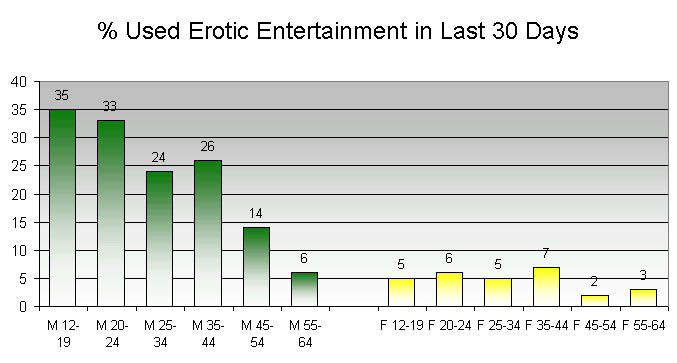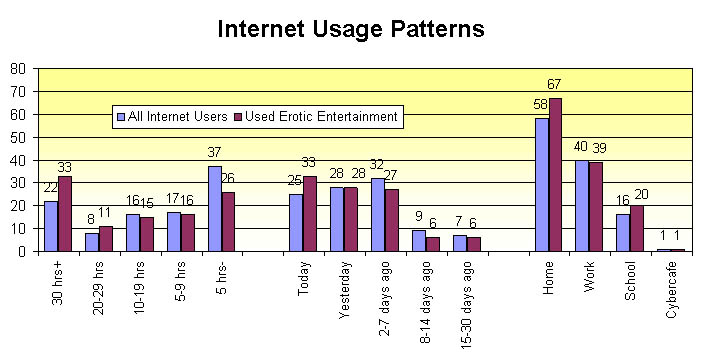
Pornography on the Internet

The year 2001 has not been kind to the new economy, as the dot-com bubble burst in spectacular fashion. Once-promising dot-coms turned out to be premised on unrealistic business plans. E-commerce fall far short of the rosy projections and advertising revenues were in the doldrums that not even creative accounting procedures could disguise. But there was one sector of the industry that did not appear to suffer --- pornography (or, shall we say, erotic entertainment?) on the internet! Or so it appears. After all, the finances of such sites are not publicized widely due to the fact that not many respectable persons wish to be identified or associated with this particular industry. Still, we can make this inference from the observation that many more mainstream internet companies have failed than those in erotic entertainment.
We will now cite some survey data from the TGI Brasil study. Within this study, 3,069 respondents between 12 to 64 years old (projecting to 11,542,000 persons in Brazil) said that they had used the internet within the last 30 days. Among these respondents, 17% of them said they had access the World Wide Web for erotic entertainment within the last 30 days. Now, the reader ought to take into consideration that the information is collected during a personal interview and there may be some social taboo against claiming this specific type of behavior to a stranger.
It should come as no surprise just who these users of erotic entertainment are. The next chart breaks down the responses by age/sex groups. Above all, it is the raging hormones of young males that are the key traffic drivers.

In the above chart, the highest usage occurred among male teenagers. This says that the presence of warning signs on the front page to prevent or persuade minors from entering an erotic entertainment website probably has no effect whatsoever other than relieving responsibility on the operator's part. This finding is not exactly a novel discovery, and the whole notification process is a big sham.

The next chart is a comparison of the internet usage patterns of the erotic entertainment users against the general population of internet users. The erotic entertainment users are more heavier users, although we cannot conclude that all the additional time is spent with pornography. They are also more likely to be home and school users, as this type of activity is certainly deemed to be inappropriate in a workplace.

As a new medium, the Internet had held out great promises for old media brands to create instantaneous brand extensions. It is obviously infinitely easier to create a brand extension than to build a new brand from scratch.
Within the TGI Brasil study, we also asked about magazine readership. The chart below shows the results for the two largest adult entertainment magazines in Brazil. These are not two sleazy titles wrapped in plastic bags, but they are published by established companies. Within the group of all Internet users, 14% were Playboy readers; within the Internet users who used erotic entertainment, readership of Playboy rises to 40%. Within the group of all Internet users, 3% were Sexy readers; with the Internet users who used erotic entertainment, readership of Sexy goes to 10%.

Both Playboy and Sexy magazines have premium websites (that is to say, they can be only accessed by paying a subscription fee). Unfortunately, the TGI Brasil study does not measure usage of those two specific websites, and we don't know how popular or financially successful these brand extensions were. Unlike their print versions, these two websites would have to compete against a large number of free websites that can be accessed anonymously. In the mainstream media, the evidence so far seemed to suggest that premium websites are not exactly big financial hits.
(posted by Roland Soong, 1/13/2002)
(Return to Zona Latina's Home Page)